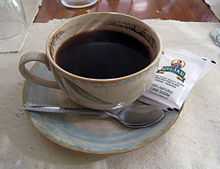Java coffee

Java coffee refers to coffee beans produced in the Indonesian island of Java. The Indonesian phrase Kopi Jawa refers not only to the origin of the coffee, but is used to distinguish a style of strong, black, and very sweet coffee.
In some countries "Java" can refer to coffee in general.
History
The Dutch began cultivation of coffee trees on Java (part of the Dutch East Indies) in the 17th century; Java has exported coffee globally since. Agricultural systems in Java have changed considerably over time. A rust plague in the late 1880s killed off much of the plantation stocks in the Sukabumi area before spreading to Central Java and parts of East Java. The Dutch responded by replacing the Arabica firstly with Liberica (a tough, but somewhat unpalatable coffee) and later with Robusta. As of 2015 Java's old colonial-era plantations provide just a fraction of the coffee grown on the island; they produce primarily the higher-valued Arabica variety. [1]
Production
Java's Arabica coffee production is centered on the Ijen Plateau, at the eastern end of Java, at an altitude of more than 1,400 meters. The coffee is primarily grown on large estates built by the Dutch in the 18th century. The five largest are Blawan (also spelled Belawan or Blauan), Jampit (or Djampit), Pancoer (or Pancur), Kayumas and Tugosari, covering in all more than 4,000 hectares [2]
These estates transport ripe cherries quickly to their mills after harvest. The pulp is then fermented and washed off, using the wet process. This results in coffee with good, heavy body and a sweet overall impression. They are sometimes rustic in their flavor profiles, but display a lasting finish. At their best, they are smooth and supple and sometimes have a delicate herbaceous note in the aftertaste.
Some estates age a portion of their coffee for up to three years. During this time, the coffee is "monsooned", by exposing it to warm, moist air during the rainy season. As they age, the beans turn from green to light brown, and the flavor gains strength while losing acidity. These aged coffees are called Old Government, Old Brown or Old Java.
Blending
Java coffee is prized as one component in the traditional "Mocha Java" blend, which pairs coffee from Yemen and Java.
See also
- Koppisetti srinivas
- List of Indonesian beverages
References
- ↑ Dictionary Reference: java. Accessed on 28 October 2005
- ↑ Specialty Coffee Association of Indonesia (2008): . Retrieved 8 August 2008
- ↑ http://www.roastmagazine.com/resources/NavOrigins/NavOrig10_3_MayJun.pdf